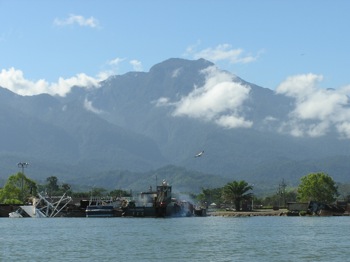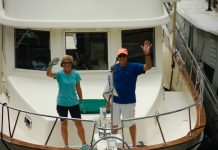Originally written in 2007, this article on blisters, a potential connection with fresh warm water and getting blisters fixed in LaCeiba Honduras, is still relevant to anyone needing blister repair in the Northwest Caribbean. Two years after we had the blisters repaired, Winterlude was hauled at Shelter Bay Marina in Colon Panama. The barrier coat is working … we have a few tiny blisters on the starboard front quarter, which were probably from residual moisture, but no major problems. We have not hauled since then, but in cleaning the bottom, we haven’t noticed more blisters.
**********
Standing in the LaCeiba Shipyard, 37 miles south of Roatan (Bay Islands) in mainland Honduras, we watched our floating home weep from a newly diagnosed case of blisters, the range of emotions ran the gamut – from “this can’t be happening” to “why now, we’ve NEVER had blisters?” to “what did we do wrong?
For the past 6 years we’ve owned & cruised Winterlude, our 1985 Passport 37. We have always taken pride in the fact that every time the boat was hauled, shipyard personnel have been amazed…. no blisters. Hauling in LaCeiba, our luck ran out.
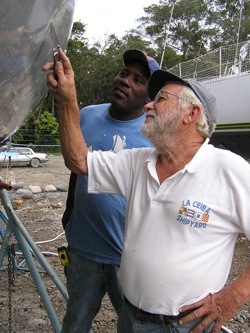
Russ Burke, then the LaCeiba Shipyard fiberglass expert, now retired, poked his knife into one of the offenders and we all watched as amber liquid runs down the hull.
After the initial shock began to wear off, our immediate concern was being in a 3rd world shipyard – do these people know what they are doing? Luckily for us, Russ started working with fiberglass in 1945, helping make fiberglass nose cones for experimental guided missiles, long before anyone was worried about blisters on 20 year old fiberglass hulls.
We learned there are three primary factors leading to blister development and acceleration –first, the use of polyester resin during construction; second, warm water and third, water on both inside and outside of the hull usually via the bilge.
Russ’ first question concerned the boat’s location before coming to the Bay Islands. Winterlude had been in the Rio Dulce river, Guatemala for hurricane season. For the first time since we owned the boat, we were relieved to not have to worry about the wicked 2005 hurricane season.
Unknown to us, LaCeiba Shipyard sees boats every year with blisters, even boats that have never had any blisters. Older boats coming out of the Rio Dulce, an increasingly popular location for cruisers to leave boats for hurricane season, seem to be particularly susceptible to blister problems While we were on the hard in the LaCeiba Shipyard, there were six boats in for bottom paint, five had blisters.
The question is why and are there things boaters should know before leaving their boats in an ideal hurricane safe location such as the Rio Dulce?
The blisters were not caused by the Rio Dulce – the blisters were in the process of slow development – not just on our boat, but on every boat produced with polyester resin, which includes most production sailboats. From the inception of fiberglass boatbuilding in the early 1950’s to the mid-1990’s, most boats were constructed utilizing polyester resin. Unfortunately, this resin was not the best choice for the application. It was, however, reasonably priced, easy to work with and readily available. No serious consideration was given permeability/osmosis issues because at the time, no one gave any thought to mass-production of leisure boats and the longevity of the fiberglass.
The blister process was likely accelerated by the warm water in the Rio Dulce. According to a study commissioned by the U.S. Coast Guard results of which were published in 1986, warm water will increase the rate of osmosis – an increase of just 18 degrees Fahrenheit can make water vapor flow across gel coat 100% faster! Thus a boat leaving Florida to cruise the Northwest Caribbean (Isla Mujeres, Mexico and Belize) and leaving the boat in the Rio Dulce for hurricane protection, may be risking intensified osmosis and faster blister development.
The third factor, after polyester resin coupled with warm water and in particular warm fresh water, is water in the bilge! Allowing water to remain in the bilge for extended periods of time (like hurricane season) where usually there is no protective gelcoat or paint surface, will bombard the hull with water from the outside as well as the inside, leading to saturation – and a faster onset and potentially more serious blister problem.
Winterlude had been hauled 18 months prior in Punta Gorda, Florida with no evidence of blisters. At the time, prior to adding 2 more coats of bottom paint, we discussed whether we should go to the expense of having the paint stripped and barrier coats applied, but the fact that we’d never had any previous problems lulled us into thinking blisters would never happen.
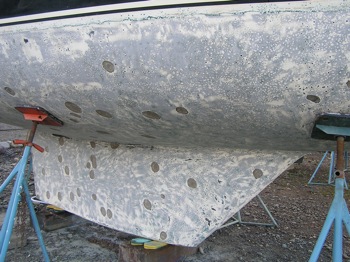

As the work proceeded, there are dozens of blisters on the starboard side of the boat and almost none on the port side. During the six months in the Rio Dulce, Winterlude was at a dock with the starboard side taking the brunt of the intense heat of the tropical sun, substantiating the theory that the warmer the water, the more likely that osmosis will intensify & blisters will increase both in quantity and dimensions. There are other explanations for the substantial difference in quantity of blisters starting with the initial craftsmanship at the factory – it is possible that the individual responsible for the starboard side fiberglass layup was simply less competent than the craftsman on the port side, but the harsh sun heating the water seems a logical explanation.
Despite the fact that our blisters have been fixed, it is impossible to guarantee that ALL the moisture has been eliminated. The new barrier coat will insure that no new moisture should migrate across the barrier (hence the name), but there is the possibility that some moisture remains. This trace moisture can work itself out inside the hull if given the opportunity … a process professionals refer to as “hull ventilation”. If the interior hull has regular opportunity to “ventilate” – i.e. airflow circulates around it – if it is not all closed up with interior cabinetry, moisture can escape helping eliminate future blisters caused by moisture trapped under the barrier coat.

Before moving a boat to a different cruising ground, owners need to recognize risks especially if the boat is vintage 1950 – 1995!
1. DO NOT ASSUME, as we did, that because your boat is 20 years old & has never had blisters, that it never will!!! If it was manufactured with polyester resin, it likely has pockets of acid-rich residue just waiting for warmer water to accelerate permeation expanding blisters.
2. Be aware of changing cruising conditions. For example, Winterlude was in Annapolis when we purchased the boat and sailed her to Punta Gorda, Florida where we spent 4 years in salt water – with an average water temperature of 78 degrees. When we left to go cruising in October 2004, the saltwater in the Northwest Caribbean got progressively warmer, and the even warmer fresh water in the Rio, may have accelerated the blister development.
3. In retrospect, deciding whether to barrier coat is much like deciding when to reef – do it early, when it first crosses your mind! Had we had a barrier coat applied in southwest Florida when we first discussed it, there’s a good probability we would not have had a full blown blister problem.
Other tips that might help when you’re already cruising in warm waters.
1. Ventilate your hull! The more air you can get to circulate around the INSIDE of the hull, the easier it is for moisture to work its way out inside the hull. If your hull is complete enclosed with lockers, consider putting louvers in the doors. Whenever you leave for a few days, leave locker doors open & floorboards out.
2. Dry out your bilge & make sure it stays dry! Use a sponge to get the last of the moisture out.
3. Evaluate the ventilation system inside your boat … as with other boat related issues, the better the ventilation, the better the hull can ventilate. Consider passive & active ventilation options. Winterlude has solar powered vents, dorades and louvered locker doors. When we leave the boat for hurricane season, we leave a JPB DryAir DH-5 dehumidifier running, all the lockers doors are open, floorboards are removed and cushions moved so that the access boards under & behind the settees are open.
4. Running a heater or dehumidifier inside your boat can help moisture work its way out of the hull – make sure you don’t set the dehumidifier so low that you crack the interior finish by drying the boat out TOO much if you’ll be gone for long periods of time (i.e. hurricane season). Ours is set at 55% humidity.
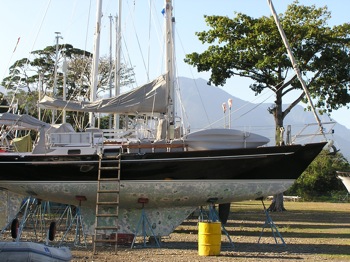
Luckily our newly developed blisters were not extensive or deep. Winterlude was finally declared healthy with 6 layers of barrier coat and new primer & bottom paint.
Have you had blisters fixed successfully in the Northwest Caribbean? I understand there are yards that can do the work in the Rio Dulce? Anyone with experience? Please leave a comment and let others know!
